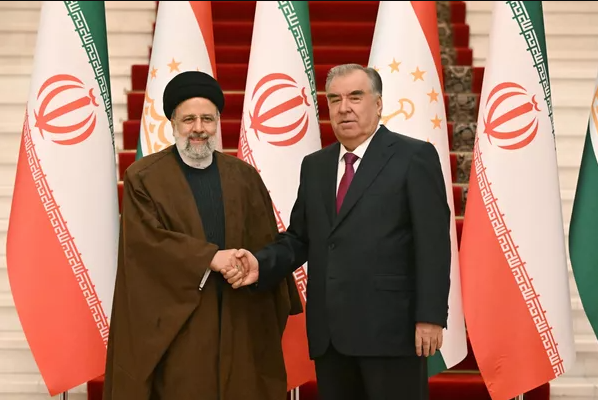
Tajikistan established diplomatic relations with Iran, with which has close cultural and ethnic links, despite the lack of a common border, at the very beginning of its existence as an independent state, – on January 9, 1992, when Iran became the first country to recognize the sovereignty of the new republic. Since, there have been frequent bilateral meetings at the highest level, including talks between the presidents of the two countries: the Tajik president has traveled to Iran 14 times, while Iranian presidents have visited Dushanbe 13 times. In the late 2000s and early 2010s, the two sides exchanged presidential visits literally every year. However, since 2015, relations between the two countries have begun to cool sharply due to Iran’s establishment of contacts with Tajik fundamentalist movements.
In recent years, the countries have again stepped up their bilateral contacts. Ebrahim Raisi’s visit to Dushanbe two years ago made history: it was the new Iranian president’s first foreign trip. Nevertheless, the good relations between the two countries cannot be put down to the intensive economic ties between the parties – the trade turnover between Iran and Tajikistan barely exceeds $ 200-250 million (which accounts for 5% of Tajikistan’s exports and just over one percent of Iran’s exports). Hence, the explanation of the two countries’ importance to each other should rather be sought in their shared cultural, linguistic and ethnic heritage, and also, as the most recent visit made clear, in such matters as transportation links and regional security.
Tajik President Emomali Rahmon met with his Iranian counterpart Ebrahim Raisi on November 8 this year.
The results of their talks can best be appreciated in the joint declaration which was presented to the public at the end of the meeting between the two presidents. This declaration reflects the two countries’ shared interest in activating transit traffic through the Iranian Chabahar Port, and specifically cites the memorandum signed by the ministries of transport of both countries on international and transit traffic through this port, and also a memorandum signed by their railway administrations on cooperation in the field of rail transport. The two countries also parties plan to cooperate on the creation of free economic zones. The importance of the Chabahar Port stems from the logistical difficulties faced by Tajikistan’s export sector – both in its present state and in relation to its future development. Significantly, the recent transportation and infrastructure projects planned by the other countries in the region in partnership with external partners (Turkey and China) almost completely bypass Tajikistan. As a result, Tajikistan is forced to take the initiative and find ways to develop the transportation links and infrastructure required to support its export sector. In this respect, access to the Gulf of Oman is clearly among Tajikistan’s priorities, particularly in view of the unfeasibility of agreeing on an alternative project with the current Afghan regime. The transportation corridor from Tajikistan to the Gulf of Oman could also be a profitable project for its northern neighbor, Kyrgyzstan, and Tajikistan’s involvement in the project could thus potentially provide it with leverage over Kyrgyzstan. This is a particularly important factor, given the ongoing border disputes between the two countries, which we have discussed in earlier articles.
In his address to the media following the negotiations with Iran, Emomali Rahmon stressed Tajikistan’s interest in attracting Iranian investment – an interest that was also evident during the recent Iran-Tajikistan Business Forum, which was attended by more than 150 companies from the two countries. In his speech, the President of Tajikistan described Iran’s participation in the construction of new hydroelectric and solar power plants in Tajikistan as a promising area for cooperation between the two countries, and specifically cited Iran’s successful participation in the construction of the Sangtuda 2 Hydroelectric Power Plant.
He also talked about the strengthening of the partnership between the two countries within the SCO, which Iran joined in July 2023 – after Tajikistan’s dropped its opposition to Iran’s membership.
In his address, Emomali Rahmon also mentioned his consultations with Ibrahim Raisi on regional security issues, and, unsurprisingly, cited the situation in Afghanistan as the most pressing concern. Predictably, the talks between the two countries focused as much on this area as they did on the transportation and economic issues. Tajikistan and Iran plan to expand the production of Iranian UAVs in Tajikistan, and also intend to hold joint military exercises.
Tajikistan is certainly hoping for Iran’s military and political support in its uneasy relations with Kyrgyzstan, and in relation to its concerns about the oppression of ethnic Tajiks and the ongoing political Islamization in Afghanistan, which Tajikistan sees as a potential threat to its statehood. As far as the dispute with Kyrgyzstan is concerned, the Turkic countries in Central Asia are disinclined to stand up for Tajikistan, while Russia, as the main guarantor of Tajikistan’s security, seeks to maintain friendly relations with both sides.
For Iran, a turn towards its eastern partners, including Tajikistan, can be seen as a mean of countering the growing influence of its rivals Saudi Arabia and Turkey in the region. Tajikistan, as the closest Central Asian country to Iran in cultural and ethnic terms, may well become the first country in the region with which Iran chooses to develop its relations.
The recent developments mark a fundamentally new stage in Iran’s relations with Tajikistan and, in the wider sense, with the Central Asian countries. It is worth noting that these relations are now destined to grow within the SOC, which represents a wide geographical, political and ideological community. In view of the current partnerships between Russia and Iran, China and Russia, and China and Iran, the processes and initiatives described in this article will assist in developing ties between the peoples of the planet’s largest continent.
Boris Kushkhov, the Department for Korea and Mongolia at the Institute of Oriental Studies of the Russian Academy of Sciences, exclusively for the online magazine “New Eastern Outlook”.
